In this article
The ability to hang on, to stick that desperate move, often comes down to one thing: grip strength. It’s the direct line to conquering more challenging climbs and boulder problems, a key component of a climber’s physical strength. Many rock climbers hit a plateau, their progress stalled by forearms that pump out too quickly or fingers that can’t quite hold onto those smaller holds, indicating a need for better grip strengths. This piece will explore everything from the anatomy of your grip and the different grip types you’ll use, to specific grip strength exercises for climbing, training plans, and vital injury prevention tactics. Prepare to unlock actionable strategies for real gains in your overall grip strength and overall climbing performance.
Understanding the Anatomy of Your Grip
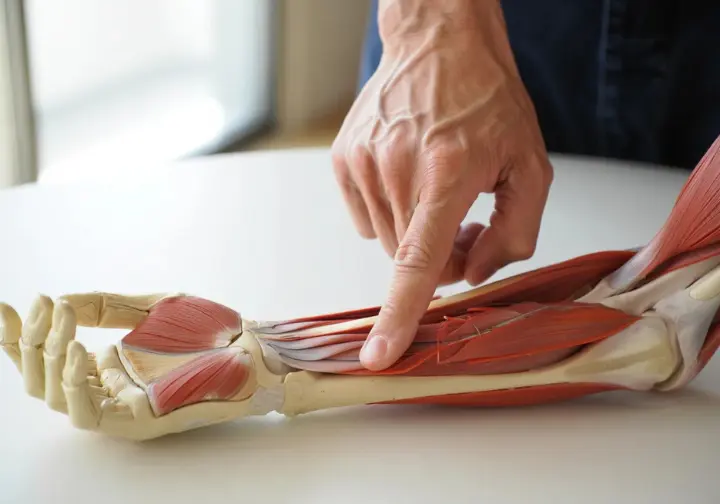
To truly enhance your hold on the rock, we first need to explore the biological machinery at play. The forearms, hands, and fingers form a complex system involving intricate muscle architecture. Understanding how these parts work together is foundational for effective strength training and, just as importantly, for sidestepping common injuries. A grasp of forearm and finger anatomy for climbing is your first step towards stronger, more resilient hands and achieving excellent grip strength.
Forearm Muscles: The Engine of Your Grip
The primary forc for your grip originates in the forearm muscles (flexors, extensors). Muscles like the Flexor Digitorum Profundus and Superficialis are key for closing your hand and are the powerhouses for all gripping actions; these muscl groups are located in your forearm, not your fingers themselves. Conversely, extensor muscles, such as the Extensor Digitorum, act as stabilizers for the wrist during flexion and are vital for opening your hand. Balanced strength between these groups prevents injuries and is crucial for forearm muscle development.
Different climbing styles place varying demands on these muscles. Long sport climbing routes test forearm enduranc and stamina, while short, powerful boulder problems require maximal strength potential. Training should ideally address both aspects for well-rounded climbing performance. An imbalance between these muscle groups can lead to common climbing injuries, so understanding this anatomy helps in selecting targeted grip strength exercises climbing. For those interested in a deeper exploration, understanding the muscles of the forearm and hand is beneficial. The intricate biomechanics of finger flexors is also a subject detailed in scientific literature for those keen on advanced understanding of forearm flexion and how these muscles means so much for a rock climber. Considering foundational strength exercises for climbing complements this anatomical knowledge.
Hand and Finger Structures: The Transmission
Intrinsic hand muscles, like lumbricals and interossei, contribute to fine motor control and pinch strength. These smaller muscles are active in adjusting your grip on nuanced holds, contributing to overall hand strength. The force from your forearm muscles is transmitted to your finger bones via strong cords known as finger flexor tendons (FDP and FDS). These tendons are susceptible to high loads and can develop tendonitis if not conditioned properly, impacting your ability to lift and hold.
A critical component is the pulley system (annular A1-A5 and cruciform C1-C3 pulleys), influencing the mechanical position for force transfer. These structures keep flexor tendons close to the bone, optimizing mechanical advantage and preventing “bowstringing.” The A2 and A4 pulleys are the largest and most frequently injured, particularly during crimping. Ligaments provide joint stability in fingers and wrists, stressed during certain grip types or dynamic moves. Learning about supporting finger structures when climbing can be beneficial for preventing muscle injury. For those interested in the detailed anatomy of finger pulleys or understanding finger joint biomechanics, specialized resources are available, which can lead to increased hand strength.
Distinguishing Grip Strength vs. Finger Strength
Often, “grip strength” refers to the overall grip strength generated by the hand and forearm, covering actions like crushing and supporting – your broad capacity to apply force. “Finger strength,” on the other hand, is the specific strength ability of your fingers to apply that force to holds, especially small or awkward ones. It’s about precise application at the point of contact with the rock, a key factor in advancing climbing grades.
While connected, strength training can target these aspects differently. General grip exercises might build forearm mass and overall strength, while hangboarding specifically hones finger strength on various hold types. Climbers need both: general grip for overall enduranc and power, and specific finger strength to latch onto diverse holds. Exploring specific finger training techniques can provide targeted ways to improve this practical finger strength. Some discussions help in defining types of hand strength, and there’s ongoing research on finger strength in climbers to determine relative grip strength.
Mastering Different Types of Climbing Grips

Excelling in climbing means becoming proficient in a spectrum of grip techniques. Each common type of grip has its own mechanics, typical applications, and grip training considerations. We’ll break these down to help you understand how to approach them and choose the appropriate grip position for different scenarios in actual climbing practice.
The Crimp Grip Family (Full, Half, Open)
The full/closed crimp involves significant PIP joint flexion (around 90-100°), DIP joint hyperextension, and the thumb wrapped over the index finger. It’s used for maximum forc on small edges but places high stress on A2/A3 pulleys; this is a crucial grip but can be a risk grip position. The half crimp grip sees PIP joints at about 90° with DIPs slightly flexed or neutral, and the thumb typically alongside. It’s versatile for small to medium edges and often considered a safer primary training grip type for developing finger strength.
The open crimp/chisel grip features less flexed PIP joints and often actively flexed DIP joints, with fingers more extended. It’s useful for sloping edges, rounded crimps, or when maximizing finger pad friction is key, generally placing lower stress on pulleys. Training for each crimp type demands cautious, progressive loading, especially for full crimps. Specific hangboard/lifting edge sizes can target these variations. Understanding the essential climbing grip types is fundamental, and the biomechanics of crimp gripping has been analyzed by experts. You’ll use these specific grip positions on many different types of climbing holds.
Pinch Grip: Squeezing Your Way Up
A pinch grip involves applying opposing forc between the thumb and one or more fingers. This is necessary for gripping features that protrude, like arêtes, tufas, or pinch blocks. Pinches vary: narrow ones demand thumb adductor and flexor strength, while wider pinches engage more hand and wrist stabilizing muscles. The width and depth significantly alter the mechanics of this specific grip type.
The muscles primarily engaged are thumb flexors/adductors/opponens, finger flexors, intrinsic hand muscles, and forearm muscles for stabilization. The thumb plays a unique role in thumb strength. Training strategies for pinch strength include using pinch blocks and other training tools of varying widths with added weight, or system board pinches. A common pinch strength exercise is lifting pinch blocks. Many climbers seek information on training pinch strength for climbing and understanding different climbing holds that require this technique.
Sloper Grip: Mastering Friction and Body Tension
Sloper grips are open-handed grips on rounded, featureless holds. Success here relies heavily on maximizing surface area contact, friction gripping, and precise body positioning, rather than pure finger strength. The palm often plays a significant role. Critical to using slopers effectively is body tension, core engagement, and shoulder stability. The direction of pull and keeping your center of gravity low and close to the wall are key for a solid grip.
Muscles involved include forearm flexors working isometrically, wrist flexors/extensors for stability, and significant engagement from the core and shoulder girdle. For training, on-the-wall practice on sloper-heavy routes is often most effective. While hangboard slopers exist, they may not fully replicate the body tension component. System board training on slopers can also be beneficial. There are many techniques for climbing slopers, and you can find expert advice on handholds and grip technique to improve. The importance of body positioning and balance cannot be overstated here when dealing with these friction grips.
Open Hand & Pocket Grips
The open hand/drag grip, an open grip dominant style for some, involves fingers being extended or only slightly flexed at the PIP joints, often with active DIP joint flexion (e.g., three-finger drag). It’s useful for maximizing skin contact, conserving energy on lengthy climbs, using pockets, and is generally less stressful on finger pulleys than crimps. Pocket grips use one (mono), two (bi-doigt), or three fingers inserted into small openings. These require precise finger placement and can place very high, isolated loads on individual finger tendons and pulleys. This is one of the open grip positions a climber must master.
The specific muscles engaged for open-handed grips are the FDP for DIPs and FDS, with forearm flexors less contracted than in crimps. Pockets cause intense localized stress on individual finger strength. For training open-hand grip endurance, hangboard repeaters are good. For pockets, approach with extreme caution and progressive loading on hangboards, focusing on even loading. The risk of injury with pocket training is very high if not done carefully. Many resources detail using different climbing techniques, and studies analyze sport-specific grip force in rock climbers, including flexion-extension grip force. This knowledge helps in mastering advanced climbing techniques.
Foundational Grip Strength Exercises for Climbing
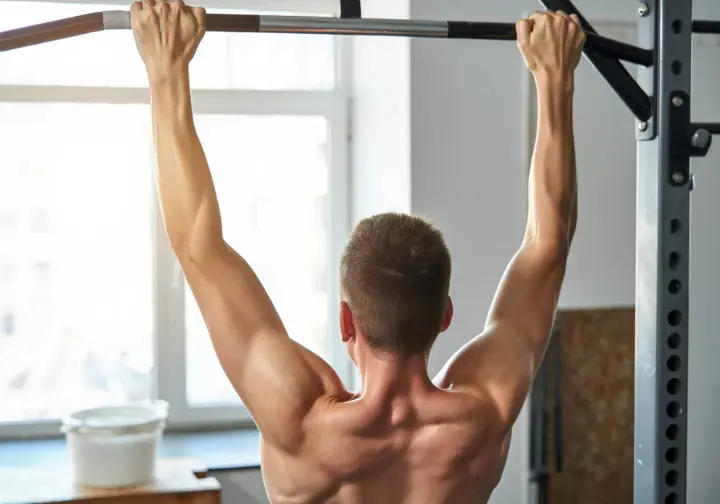
Building a strong base for climbing-specific grip is where these fundamental exercises come in. This section covers strength exercis targeting overall hand, wrist, and forearm power, many requiring minimal equipment. These are essential grip strength exercises for rock climbing base fitness, forming a solid grip-strengthening routine. Many are common exercise options that provide fresh exercises for your workouts.
Bodyweight & Minimal Equipment Exercises
Dead hangs from a pull-up bar build support grip endurance and shoulder stability. Variations include two-arm, one-arm (advanced), and timed hangs; always maintain engaged shoulders and a tall posture. Towel pull-ups/hangs, using a towel over a bar, create an unstable grip, heavily recruiting forearm and hand muscles for crush grip and finger strength. An exercise mat can provide comfort for ground-based exercises.
Rice bucket exercises involve various hand and wrist movements in rice, developing balanced strength in forearm flexors and extensors, aiding injury prevention. Finger curls with minimal weight or resistance bands isolate finger flexor muscles to build foundational strength. Many of these are excellent grip strength exercises at home. You can find demonstrations, including details in a no equipment grip training video, to perfect your form for effective at-home climbing workouts. These functional fitness exercises are great for any athlet.
Exercises with Free Weights
Farmer’s walks, holding heavy dumbbells or kettlebells in each hand and walking, build tremendous support grip strength and forearm enduranc. Plate pinches, squeezing two or more weight plates together (smooth sides out) with fingers and thumb, are superior for pinch strength. This is a great specific exercise for that grip type.
Wrist curls (palms up) and reverse wrist curls (palms down) with dumbbells or a barbell directly strengthen forearm flexor and extensor groups. Barbell finger curls, letting a barbell lift to fingertips then curling it back, target finger flexor muscles for an enhanced crushing grip. You can find various grip workout routines with weights online. This type of strength training for climbing performance is very effective when incorporating free weights into climbing training. Using free weight is a classic way to build strength.
Using Resistance Bands for Grip
Finger extensions with rubber bands around fingers provide resistance training for antagonist muscl groups. This balances strong flexors, helping prevent issues like climber’s elbow. Resistance bands can also be used for wrist flexion/extension, offering portable and variable resistance. This is a good separate exercise for the forearm antagonist muscle.
A thick resistance band can be squeezed for crush grip strength, an alternative to traditional hand grippers. Resistance bands are portable, offer accommodating resistance (increasing through the motion), and are versatile for various angles. Knowing hand grip strengthener proper form is important even with bands. These exercises contribute to how to improve grip strength generally and are useful for preventing elbow pain with antagonist exercises. A grip ring or grip rings like the o-zone grip ring are also portable options for finger exercisers.
Advanced Grip Training: Hangboards & Specialized Tools
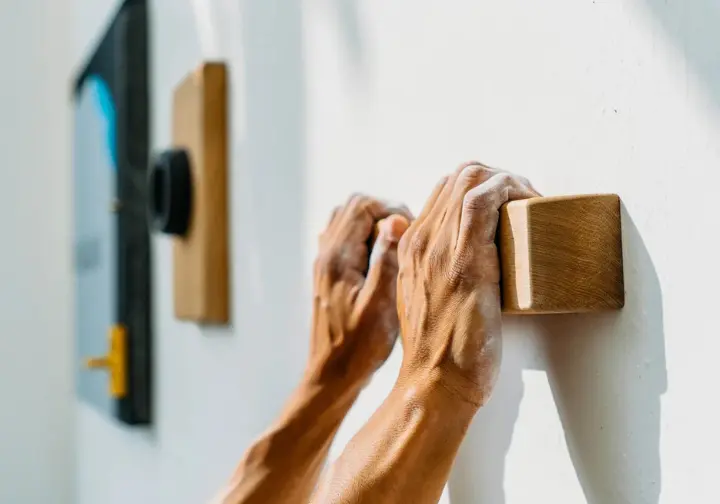
For those ready to elevate their grip, we explore advanced, climbing-specific strength training methods. Hangboards (or fingerboards) and other specialized grip training equipment are designed to push your limits in climbing grip strength training. Here, proper technique and careful progression are absolutely paramount for any advanced climber.
Hangboard Training Essentials
Hangboards, also known as fingerboards, are highly effective for developing climbing-specific finger strength. They allow isolated, controlled loading of various grip types like crimps, slopers, pockets on different edge sizes. Before starting hangboard/lifting, a solid climbing base (e.g., 1-2 years consistent climbing, comfortable on V4-V5 or 5.11-5.12 routes), healthy fingers, and thorough warm-ups are prerequisites to minimize injury risk and build beginner finger strength foundations. Many climbing gyms have these available.
A secure mount, chalk, and potentially a soft landing are part of a safe setup. Maintaining engaged shoulders (scapular retraction) and a slight bend in elbows during hangs is vital. Common grip positions include the half-crimp (often the primary training grip), open-hand/drag, and cautious use of pockets or slopers. Full/closed crimping is generally discouraged for most hangboard training due to high injury risk. Many resources detail fingerboard strength protocols that work and explain how to use a hangboard to train. Consider this when setting up your home training area in your personal gym.
Popular Hangboard Protocols (Max Hangs, Repeaters)
Max Hangs involve short hangs (e.g., 7-10 seconds) at high intensity (weight on small edges or added weight on larger ones), with long rests (e.g., 2-3 minutes). This protocol builds maximal strength potential in finger strength. Repeaters consist of multiple sets of shorter hangs with incomplete rest (e.g., 7 seconds on, 3 seconds off for 6 reps), followed by a few minutes rest between sets. This targets strength-endurance and resistance to forearm pump, crucial for power endurance/ endurance. This is a key part of training finger strength.
Max Hangs are generally better for pure strength development, often suited for bouldering, while Repeaters target enduranc, more applicable for sport climbing. Many climbers incorporate both. Critical for all protocols are consistency, progressive overload (gradually increasing difficulty), listening to your body, and adequate recovery (24-72 hours) between intense finger strength session periods. You can find articles comparing hangboard protocols and research on hangboard training protocols to deepen your understanding when structuring training for bouldering improvement. A max strength test can help track progress, giving you a max strength score or finger strength score.
Other Specialized Grip Trainers
Hand grippers (e.g., Captains of Crush) or an adjustable hand gripper develop crush grip strength. They come in different resistance levels. While useful for general hand strength, their transfer to specific grip strengths in climbing may be less direct than hangboards. Pinch blocks/rollers allow targeted pinch strength training with added weight; wrist rollers develop forearm strength and enduranc, particularly for wrist flexion and extension. Using a gripper is a form of hand gripper training.
Campus boards are highly advanced tools for contact strength and upper body power, used primarily by elite climbers. They carry an extremely high injury risk. Attachments like Fat Gripz make bars thicker, increasing demand on grip and forearm activation during regular exercises. There is much to learn about advanced hangboard training technique, and it’s wise to be aware of common campus board training mistakes. Some of this specialized grip training equipment as gifts can be great for dedicated climbers. Adjustable grippers offer varied resistance.
Structuring Your Grip Strength Training Plan

Effectively weaving grip strength exercises for climbing into a cohesive workout plan is next. This involves understanding workout design, frequency, intensity, and how to periodize for different climbing levels. A good plan considers your current grip strength levels.
Key Training Principles (Overload, Specificity, Recovery)
Progressive overload is fundamental: the training stimulus must gradually increase. This can be done by increasing weight/resistance, reducing hold size, or increasing volume. Specificity means strength training should mimic the demands of climbing. This means prioritizing exercises and grip types that are directly relevant to on-wall performance (e.g., finger strength on edges for crimpy routes, pinch strength for pinch-heavy problems). This is key for building strength that translates.
Rest & Recovery are when adaptations occur. Adequate rest between sets, sessions, and cycles is vital for strength gains. Signs of overtraining necessitate deloads or active recovery. Consistency is also paramount; sporadic efforts yield little. Adherence to a plan over months brings significant improved grip strength. Familiarizing yourself with general principles of exercise and perhaps a climber’s guide to periodization will be beneficial. These principles of physical training for endurance apply broadly to any athlet.
Sample Plans: Beginner, Intermediate, Advanced
For beginners (recreational climbers climbing <1 year), dedicated grip training might be premature. Focus should be on climbing volume, learning movement, and very light supplementary workouts like rice bucket exercises. Very brief, bodyweight-only hangs on large holds can be introduced, emphasizing form. Intermediates (1-3 years, solid V3-V5 / 5.10-5.11) can introduce structured hangboarding 1-2 times weekly (basic repeaters or max hangs on comfortable edges), plus 1-2 other general grip exercises, integrated with 2-3 climbing sessions. These plans help with gradual grip strength improvement.
Advanced climbers (3+ years, V6+ / 5.12+, often male climbers and female climbers pushing limits) might use complex periodized plans, with 2 hangboard sessions targeting different aspects (e.g., one max strength, one enduranc). May incorporate campus board work or other specialized tools cautiously. Higher intensity and volume require deliberate recovery. For all levels, a thorough warm-up is non-negotiable, and grip work should be integrated appropriately with climbing sessions. You can find a basic outline of a training plan online or general advice on training for rock climbing. This helps in structuring training for specific climbing disciplines for any serious rock climber.
Integrating Grip Training with Climbing Sessions
The timing of grip training varies. Some prefer it after climbing sessions (when warmed up but potentially fatigued), others on separate climbing days to be fresh. Balance volume to avoid overtraining; a hard bouldering climbing session and an intense hangboard workout on the same day might be excessive. Consider periodization: cycle grip training intensity and volume throughout a climbing season or training block (e.g., strength focus in off-season, maintenance during performance phases). How do you currently balance your strength workouts? Ultimately, listen to your body. If performance suffers or pain develops, re-evaluate. Consider the optimal training for climbers with a full-time schedule and be mindful of how often to do finger intensive activities. The importance of rest and recovery in climbing cannot be overstated.
Injury Prevention: Protecting Your Hands and Forearms
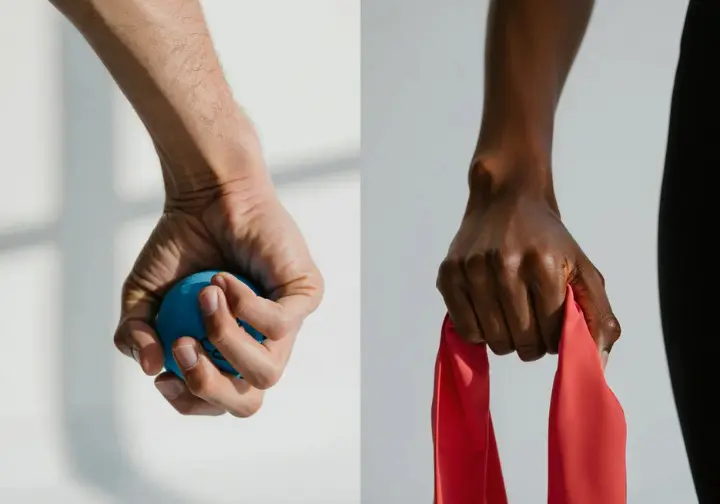
This critical section focuses on strategies to prevent common climbing-related grip injuries. We’ll cover warm-ups, cool-downs, antagonist muscl training, and recognizing early warning signs to keep you climbing strong and avoid muscle injury.
Common Grip-Related Injuries in Climbers
Pulley sprains/ruptures (A2, A4) are among the most frequent acute finger injuries, often from forceful crimping, causing a pop, pain, and swelling. Flexor tendonitis/tenosynovitis is inflammation of flexor tendons or sheaths from overuse, leading to pain and stiffness. Epicondylitis (Golfer’s/Tennis Elbow) involves pain at the inner (medial) or outer (lateral) elbow due to overuse of wrist flexors or extensors, respectively. Carpal Tunnel Syndrome can also arise from repetitive gripping. Awareness of common climbing injuries is the first step. Specific conditions like rock climbing finger tenosynovitis have detailed explanations available from medical professionals. This knowledge reinforces understanding safety protocols in climbing.
Effective Warm-Up Routines
Begin with 5-10 minutes of general cardiovascular fitness activity like jumping jacks to increase overall body temperature and blood flow, improving agility. Follow with dynamic stretches for major climbing muscles: arm circles, wrist circles, and gentle finger flexions/extensions. Avoid static stretching before activity. Gradually introduce climbing-specific movements, starting with very easy climbs or large holds on a system board or hangboard, progressively increasing intensity. For specific finger warm-up, try light hangs on comfortable hangboard edges or use therapy putty. Detailed guides on finger warm ups for climbing and how to warm up properly for climbing are valuable. Our own structured warm-up hacks for climbers can also be very helpful.
Antagonist Training for Balanced Strength
Antagonist muscles perform opposite actions to primary movers (agonists). For climbers, agonists are primarily gripping/pulling muscles (flexors); antagonists are opening/pushing muscles (extensors). Repetitive gripping actions can lead to significant strength imbalances between flexors and extensors in the forearms, wrists, and shoulders. These imbalances are a major contributor to injuries like elbow tendinopathies and wrist pain. Key antagonist muscl exercises include finger extensions (rubber bands), reverse wrist curls (dumbbells or bands) for forearm extensors, push-ups and dips for chest, shoulders, triceps (opposite to pulling muscles). Aim for 1-3 antagonist sessions per week, often on rest days or after climbing/strength training, keeping intensity moderate. There are many resources on effective forearm antagonist training for climbers and general antagonist workouts for climbers. This type of training is key to integrating mobility and strength for injury prevention.
Listening to Your Body & Basic Rehab Concepts
Recognize early warning signs of injury: persistent pain (not just soreness), pain that worsens with activity, localized tenderness, or swelling. Differentiate between good training discomfort and actual pain. Do not “climb through pain,” as this often exacerbates minor issues, turning them into chronic problems. For minor tweaks, RICE (Rest, Ice, Compression, Elevation) can help with acute inflammation, followed by gentle range-of-motion exercises once acute pain subsides. Modify activity by avoiding specific grip positions or intensity. If pain is severe, persistent (over 1-2 weeks), or significantly impacts function, consult a doctor or physical therapist. Knowing how to train while injured is a skill, and understanding tendon rehabilitation principles for rock climbers can be insightful. Sometimes, basic rehabilitation concepts like finger taping can offer support.
Holistic Approach: Nutrition, Psychology & Long-Term Gains
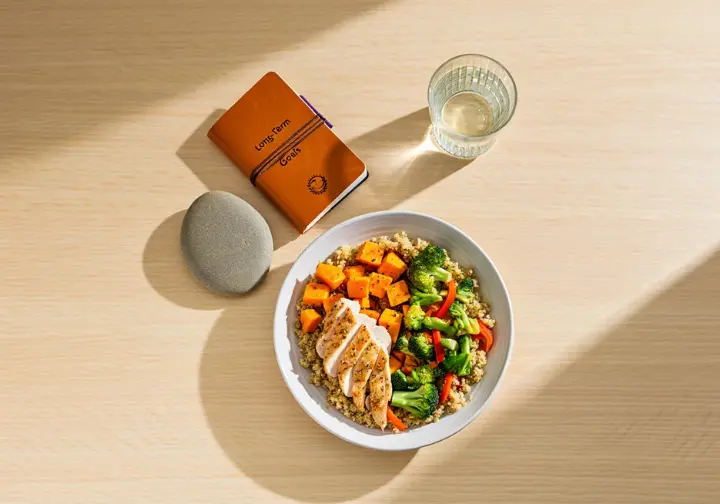
Beyond direct exercises, other factors contribute to optimal grip strength. Nutritional support for recovery, the psychological aspects, and considerations for long-term development all play a part in achieving phenomenal grip strength.
Nutritional Support for Strength & Recovery
Building and repairing muscle, including forearm muscles and even biceps to some extent, requires adequate energy; restrictive dieting can hinder strength gains. Sufficient protein intake (e.g., 1.6-2.2g per kg body weight for active individuals) supports muscle protein synthesis and repair micro-trauma from strength training. Nutrients like Vitamin C, collagen/gelatin, and amino acids (glycine, proline) may play a role in tendon and ligament health and repair, though more research is ongoing. Staying well-hydrated and ensuring adequate micronutrients are also important for optimal muscle function and tissue repair. Some focus on climbing training nutrition to improve tendon health, and for more specific advice, you can explore nutritional considerations for female rock climbers. Exploring various dietary approaches for athletes can be beneficial.
The Mental Game: Confidence and Focus
A stronger grip directly translates to increased confidence on the wall. Knowing you can achieve a solid grip on smaller or more difficult holds, avoiding a weak grip, reduces fear and allows for more committed grip strength movement. The role of focus during grip-intensive moves or strength training is also vital; concentrating on precise finger placement and forc application can be the difference between sticking a hold or peeling off. Improved grip strength can alleviate some of this fear by increasing perceived control. Achieving grip strength goals offers psychological benefits like increased motivation, resilience, and a sense of accomplishment that positively impacts overall climbing enjoyment. The psychological benefits of rock climbing are numerous, and studies explore psychophysiological response differences in climbers. This all contributes to building confidence through climbing.
Long-Term Physiological Adaptations
Consistent, long-term grip training leads to muscular adaptations in tendons and ligaments, making them thicker, stronger, and more resilient to injury. This process of building strength is slow but vital. Studies show climbers can develop increased cortical bone thickness in climbers in their fingers and hands in response to sustained loading over years. Neuromuscular adaptations: improved motor unit recruitment, rate of force development (RFD), and intramuscular coordination contribute significantly to strength gains, often preceding visible muscle hypertrophy. Patience is key; significant, lasting changes in grip strength and connective tissue resilience take years, not weeks or months, of dedicated and smart strength training. An average strength gain is steady. Research also explores other factors influencing osteological changes in climbers. It’s another aspect of understanding physiological factors in climbing and achieving a robust grip.
Key Takeaways for Stronger Climbing Grips
- Mastering grip strength is a journey that combines understanding anatomy, consistent targeted strength training of various grip types, and diligent injury prevention. This includes various grip strength exercises for climbing.
- Prioritize proper technique in both climbing and grip-specific exercises; quality of movement and loading trumps sheer quantity for improved grip strength.
- Integrate foundational exercises, hangboard protocols, and antagonist muscl work into a structured, periodized plan that aligns with your climbing level and goals for climbing grip strength training.
- Listen to your body, prioritize recovery, and address pain or discomfort early to ensure long-term, sustainable progress and avoid setbacks from a certain workout.
- Embrace the process: significant grip strength gains take time, dedication, and a holistic approach that includes nutrition and mental fortitude, ultimately unlocking your potential to climb harder and more confidently. This journey is about building a strong grip for all grip strength sports.
Frequently Asked Questions about Grip Strength for Climbing
How long does it take to see improvements in grip strength for climbing? >
Can I improve my climbing grip strength without a hangboard? >
How often should I train grip strength for climbing? >
What’s more important for climbing: finger strength or forearm endurance? >
We are a participant in the Amazon Services LLC Associates Program, an affiliate advertising program designed to provide a means for sites to earn advertising fees by advertising and linking to Amazon.com. As an Amazon Associate I earn from qualifying purchases. We also participate in other affiliate programs. The information provided on this website is provided for entertainment purposes only. We make no representations or warranties of any kind, expressed or implied, about the completeness, accuracy, adequacy, legality, usefulness, reliability, suitability, or availability of the information, or about anything else. Any reliance you place on the information is therefore strictly at your own risk. Additional terms are found in the terms of service.











